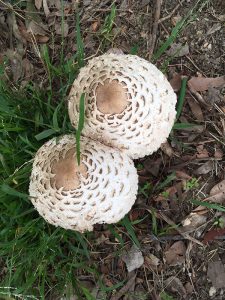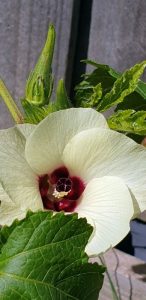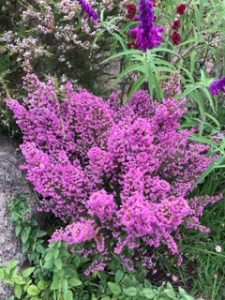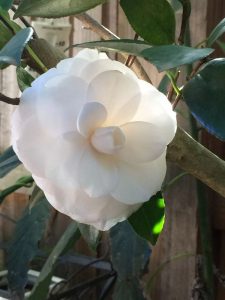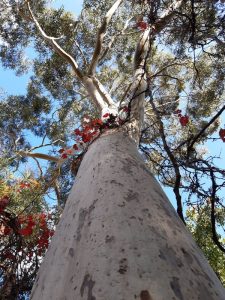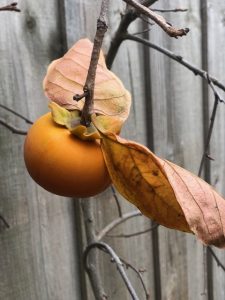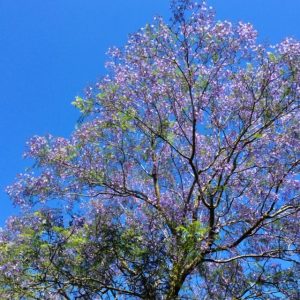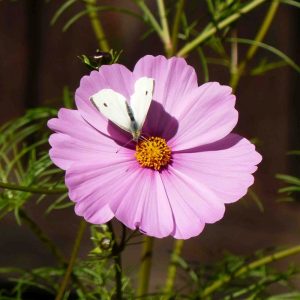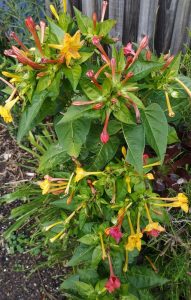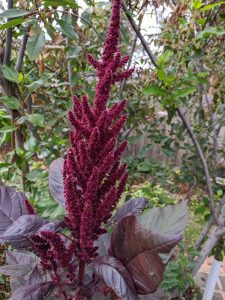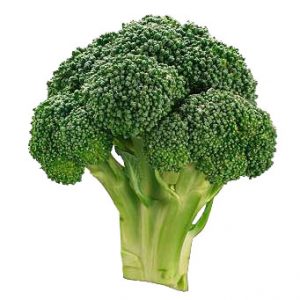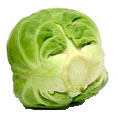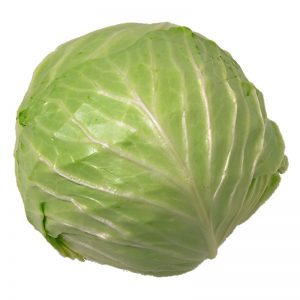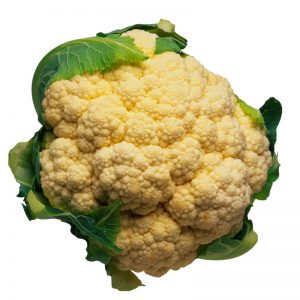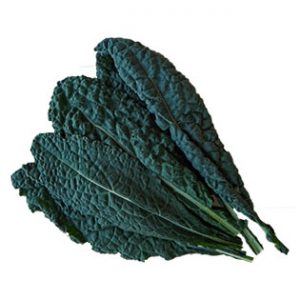Thanks to the people who have contributed to this week’s newsletter: Ann Stanley, Bruce Plain, Carol Woolcock, Chantelle Ladouceur, Choon Yeok, Chris Mills, Joanne Shiells, Jon Buttery, Judy Vizzari, Mala Plymin, Mardi Caracoglia, Marjory Gardner, Paul Hemsworth, Robin Gale-Baker, Sandie Downes, Soo Mei Leong and Velyne Moretti.
Which farmer’s markets will be happening this weekend?
Answer 3: Alphington, Coburg and Eltham. Not Bundoora Park, Carlton or Heathmont.
Judy visited Doncaster Community Gardens
Just before we all started socially isolating, Judy Vizzari visited one of the most extensive, but least known, community gardens in the whole of Melbourne, namely Doncaster Community Gardens. It covers 2½ acres and includes 140 large plots. But it is hidden in that it cannot be seen from any public road and has no presence on the Internet. Indeed, I only discovered it when I was visiting the Kevin Heinze GROW community garden, saw a second, much bigger, community garden across the road and went to explore. It is always verdant, with all the plots rented out and actively worked. It’s well worth a visit.
As Judy says in her write up, “Access to the gardens is via a rough private road which runs downwards through the car park between the Kevin Heinze GROW Centre and its commercial nursery … On the left, 23 rows of plots run south-westward. Each row comprises three large plots (10 metres by 4 metres) plus one smaller one. Grassy paths separate the rows. Each plot has its own access point with a lockable gate and most have high wire fences which double as supporting frames for a variety of climbing vegetables. To walk through them is to negotiate a maze. To the right of the road the layout is mirrored by 10 rows running north-eastward starting at the top of the hill. Each row comprises 5 large plots (10 metres by 4 metres) separated again by paths.“
“It’s tended by an eclectic mix of gardeners of Greek, Italian, Asian and Australian backgrounds” and “there’s a real feeling of camaraderie here“.
The land is available to the community garden because it is near power lines and Judy concludes that it “offers a healthy and productive outlet to many gardeners and presents a model which more councils could potentially adopt to utilise vacant land, encourage community ties, promote larder independence and inspire us all to focus on sustainable living“.
Read Judy’s full interview write up.
Robin’s tip of the month – autumnal jams
Autumn is the perfect time for making unusual jams. Trees are heavy with persimmons, guavas and feijoas at the moment and these make delicious jams.
Jam making is quick and easy and can be made in small or large batches depending on how much fruit you need to process. The basic ingredients are fruit, sugar, lemon and water. You will also need sterilised jars and cellophane covers. These can be purchased as a jam making kit by Fowlers Vacola and contain jamsetta with pectin and 24 kleeview covers. I personally don’t use pectin because I don’t find it necessary and it is easy to overdo it and produce jam that is as hard as a rock!
To sterilise jars, wash them in soapy water, rinse and drain and then place them in a cold oven set to 110degC. When that temperature is reached, turn off the oven and leave the jars for 10 minutes. Make your jam at the same time so that you are ladling hot jam into hot jars.
The basic method of making jam is to wash the fruit, cut it up or scoop out the pulp, simmer it in some water or lemon juice for 30 minutes, add the sugar and raise the heat to medium until the sugar dissolves, and then boil the mix for about 25-30 minutes until it thickens or reaches what is called the ‘setting point when the fruit turns to jam. You can test for this by dropping a teaspoon of the mix on a saucer that has had 15 minutes in the freezer. After 5 minutes on the plate, draw a spoon through it and it should wrinkle. If not, boil it a bit more and test again.
Persimmon jam: 1Kg of ripe persimmon pulp, 700 grams of brown sugar, zest of 2 lemons, juice of half a lemon and 100 ml of water. Put all in the saucepan and proceed as above. If you want to make it a spiced jam, add in a cinnamon stick and a star anise (which you remove before bottling).
Pineapple guava jam: 1Kg of fruit cut in halves, 4 cups of water, 4 cups of sugar, zest of one lemon, juice of 2 lemons, 1 tablespoon of vinegar and 1 teaspoon of salt. Put the fruit and water in a saucepan and simmer for 40 minutes. Then strain to remove the skin and seeds. The liquid may look quite grey and unappealing but the moment you add sugar it will turn to a clear, golden jam. Proceed as above adding all the remaining ingredients.
Pineapple feijoa jam: 1Kg of feijoa pulp, juice of 1 large lemon and 1¼Kg of sugar. Put all ingredients in a saucepan and proceed with method above. You can use the same recipe for strawberry feijoa jam.
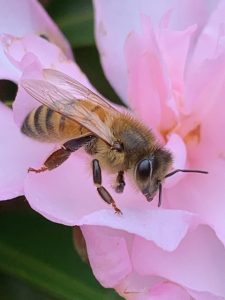 Our photo competition
Our photo competition
And last week’s winner is …
There were 13 entries, each of which is shown below. Thanks everyone! Again, the standard was high and you should click all 13 to see larger versions.
The winner is Chris Mills for her picture of a honey bee. Congratulations Chris! A birds nest fern, courtesy of Bev Middleton, will be wending its way to you.
Honorary mentions go to two very different pictures of dahlias by Joanne Shiell and Mardi Caracoglia. Congratulation Joanne and Mardi!
Here are all 13 entries (click them to see larger versions).
This week’s competition
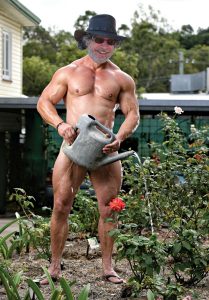 Saturday, 2nd May (i.e. this upcoming Saturday) is World Naked Gardening Day and that is going to be the theme for this week’s competition. The photo must feature some unclothed part of either yourself or someone who lives with you (with their permission of course). To illustrate one possibility, pictured is a selfie that I created earlier this week. The prize will be a $50 voucher for seedlings of your choice from The Mushroom Shed. As well as the winner, any photo given a honorary mention will also win a $30 voucher.
Saturday, 2nd May (i.e. this upcoming Saturday) is World Naked Gardening Day and that is going to be the theme for this week’s competition. The photo must feature some unclothed part of either yourself or someone who lives with you (with their permission of course). To illustrate one possibility, pictured is a selfie that I created earlier this week. The prize will be a $50 voucher for seedlings of your choice from The Mushroom Shed. As well as the winner, any photo given a honorary mention will also win a $30 voucher.
What seedlings you can choose from depends on exactly when you want them but The Mushroom Shed currently have the following available: beetroot, bok choi & pak choy, broad beans, broccoli, cabbage, cauliflower, chervil, dill, garlic, kale (black tuscan or red russian), komatsuma, lettuce (cos or 4 seasons), oregano, parsley (curly or flat), peas (sugar snap or snow), perennial basil, rocket (wild or normal), sage, silverbeet (rainbow chard or normal), sorrel, spinach (baby or normal), strawberries and thyme.
Email your photo by end of play Sunday, 3rd May.
No, you didn’t know!
No one had any suggestions about what variety Carol Woolcock’s feral tomato plant is.
Do you know?
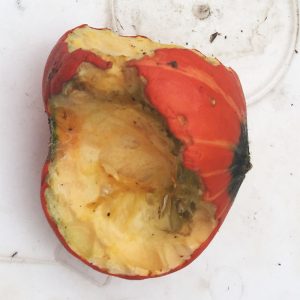 Vicki Jordan asks: “What is eating my pumpkins (see picture right)? Is it birds, rats, rabbits or something else? One day they are fine and the next time I look they are eaten. The smaller ones are not on the ground but on a trellis around 1 metre high. The large ones are on the ground and just have bits taken out of them.” Email your answer.
Vicki Jordan asks: “What is eating my pumpkins (see picture right)? Is it birds, rats, rabbits or something else? One day they are fine and the next time I look they are eaten. The smaller ones are not on the ground but on a trellis around 1 metre high. The large ones are on the ground and just have bits taken out of them.” Email your answer.
Sandie Downes asks: “I have two olive trees, variety unknown. Lots of the olives are falling off. They are small and green. Any suggestions about how to use them?” Email your answer.
Moving Feast – a collaborative response to the current pandemic
Led by STREAT, a number of social enterprises have got together to create a food response to the current pandemic based on the principles of “justice, sustainability and resilience“. Over the coming months, they will “grow, cook and deliver meals to the most vulnerable Victorians“. The response is called Moving Feast.
They envisage three phases in their response:
- Relief: immediate food relief for the state’s most vulnerable people.
- Recovery: mass production and distribution of food boxes and backyard growing kits.
- Rejuvenation: creating integrated and resilient local food systems.
The organisations involved include STREAT, 3000acres, ACRE, ASRC Catering, CERES, Collingwood Children’s Farm, Common Ground Project, Community Grocer, Cultivating Community, Free to Feed, Fruit2Work, Good Cycles, Kinfolk, Laneway, Melbourne Farmers Markets, Open Food Network, RMIT’s Bowen Street Press and Whittlesea Food Collective.
A new food outlet in Warrandyte – Replenished Wholefoods
Ann Stanley has written in: “A new food outlet, called Replenished Wholefoods, has just opened in Warrandyte. It stocks bulk wholefoods, native bush foods, fresh produce, natural cleaning products, vegan & gluten-free food, coffee and baked goods. Its espresso machine is almost ready to go! It is an independent business getting established with a strong focus on locally sourced fresh produce and other food products. It’s open 7 days, 272 Yarra Street, Warrandyte.“
Guy’s veggie growing tip – brassicas and cabbage moth
Cabbage moths lay their eggs on broccoli, brussels sprouts, cabbage, cauliflower, kale and other brassicas. The caterpillars then eat large volumes of the plant’s leaves. Jodie has written in: “Can you suggest what I can use to repel cabbage moths? They are now everywhere in my garden and holes are appearing on the foliage of my brassicas.“. Kimberley wrote in with a similar question.
Here is my answer. Fine bird netting can stop the moths laying their eggs on your brassicas. You don’t want the netting to rest on the plants, because the moths can then lay their eggs through it, so use some sort of wooden or plastic structure upon which to rest the netting. And make sure that the netting goes all the way down to the ground so that the moths can’t get underneath it.
If, for some reason, you don’t want to use netting, there is another possibility. Cabbage moths are territorial and if they see another cabbage moth in the vicinity, they tend to leave. So, either make, or buy, some decoys – just white butterfly shapes on sticks. Many nurseries sell them.
Is your soil safe?
Bruce Plain has written in to remind newsletter readers that VegeSafe, a program run by Environmental Science staff at Macquarie University, offer a very cheap ($20 donation) way of getting your soil tested for metal and metalloid contaminants. Read more. Submit sample.
18 months ago, Stuart submitted his soil for testing and wrote up the results for this newsletter.
As Stuart discussed, there are a confusing number of standards against which the safety of your soil can be judged. As Stuart discussed, and as we confirmed with the people who do the testing, the most appropriate standards to use when judging whether your soil is safe are the so-called ‘Australian NEPC Health-based investigation levels (Residential A).
How to make someone jealous
From Paul Hemsworth: “My friend in Warburton has a 12+ metre high avocado tree. I’ve no idea how old it is but it is big. Last year, it produced around 1,400 delicious avocados.“
What seeds to plant in May
Here is a list (see the planting guide for more detail):
BrassicasBroccoli |
Cool season veggiesBroad beans |
Leafy greensLettuce |
OtherCarrot |
If you haven’t planted your cool season veggies yet, plant them now.
Read Helen’s guides on growing brassicas and garlic.
Read Robin’s guides on growing broad beans, cauliflower and garlic.
Meg’s social isolation week
The multi-coloured sweet peas that I saved from last season are up already along the fence. I planted them in the last week of March. I am reminded that it is definitely time to plant peas in the veggie patch.
Thank goodness that the mail continues! I received my pea seeds today. It feels a bit like Christmas: snow pea Yakumo, sugarsnap pea Cascadia and pea Massey Gem. They should all be ready for harvesting in spring. In spring, I always make a fresh pea soup. It can also be made with frozen peas.
The weather has been fine for Anzac day and the dawn driveway services gives me plenty of time in the day to plant the peas under sturdy frames cut from a black bamboo. If birds are a problem, cover with some netting until the seedlings are established.
Fresh pea soup
350g potatoes, peeled and cubed
350g onions, diced
2 leeks, washed and diced
1½ litres good quality chicken or vegetable stock
500g peas
Salt and pepper to taste
Fry the onions and leeks in a little oil for 2-4 minutes then add the potatoes and fry for 2-3 minutes.
Add the stock and cook until the potatoes soften. Add the peas and bring to the boil quickly. When the peas are just done, remove from heat.
Blend and season to taste.
Can be served with a little cream.
Want some free seeds?
Megan has some excess pea seeds (including lots of sweet peas) that she would like to give away. If you would like some, simply email us with your preferred pea types and postal address and Megan will send you 10-20.
The most popular post on the Permaculture Victoria Facebook page currently is a post offering to send you some unspecified seeds if you send them a stamp addressed envelope. The author of the post lives in the Mornington Peninsula.
Which link was clicked most times in the last newsletter?
Callie Lastdrager’s winning picture of water droplets on a plant.
Proverb of the month
An apple a day keeps the doctor away. Meaning: eating fruit helps to maintain good health. The original phrase, first found in print in the mid 19th Century, was ‘eat an apple on going to bed, and you’ll keep the doctor from earning his bread‘ but then a few years later someone decided that this didn’t scan well and therefore re-worded the phrase as used nowadays.
 There is some ambiguity as to whether the reference to ‘apple’ should be taken to relate specifically to ‘apples’ or more generally to ‘fruit’. This reflects a longstanding ambiguity in the English language where the word ‘apple’ used to refer to any round fruit that grew on a tree. So, for example, whilst Adam and Eve’s forbidden fruit is now often depicted as an apple, it is just called a fruit in the King James Version of the Bible. According to Wikipedia, it could have been any of fig, grape, pomegranate, banana, mushroom or wheat. And Michelangelo painted the Tree of Knowledge as a fig tree (e.g. see picture right).
There is some ambiguity as to whether the reference to ‘apple’ should be taken to relate specifically to ‘apples’ or more generally to ‘fruit’. This reflects a longstanding ambiguity in the English language where the word ‘apple’ used to refer to any round fruit that grew on a tree. So, for example, whilst Adam and Eve’s forbidden fruit is now often depicted as an apple, it is just called a fruit in the King James Version of the Bible. According to Wikipedia, it could have been any of fig, grape, pomegranate, banana, mushroom or wheat. And Michelangelo painted the Tree of Knowledge as a fig tree (e.g. see picture right).
Whilst everyone agrees that eating fruit, including apples, is good for you, it appears to be a matter of scientific dispute whether or not eating an apple a day does actually have any significant health benefits. A 2015 study found that adult consumers of one small apple per day had the same number of doctor visits as those who did not eat apples but it also found that people who ate an apple a day used fewer prescription medications. They suggested that the phrase be amended to an apple a day keeps the pharmacist away but this doesn’t scan well and has therefore not caught on. There seems to be general agreement that obtaining the full health benefits from eating apples requires you to eat the peel, as this is where much of the ‘goodness’ is.
Gardening quote of the month
“It is a golden maxim to cultivate the garden for the nose, and the eyes will take care of themselves.” by Robert Louis Stevenson.
Joke of the week
Why did the cookie cry? Because his mother was a wafer so long!
Regular, current, online events
If you know of any others, email me.
Previously announced events
Sustainable Macleod are producing a series of videos entitled growing tips starring our very own Robin Gale-Baker.
Kat Lavers is publishing a series of videos entitled gardening in hard times on her Facebook page.
Pip Magazine (some of whose journalists live in North East Melbourne) are producing a series of videos entitled simple skills for self sufficiency.
3000acres are organising three, free online workshops to discuss how to preserve olives, using fresh olives harvested from our local area. Then, all together, you will preserve a small batch to put away in the cupboard. The workshops will be on: Wednesday, 29th April, 2-3pm; Sunday, 3rd May, 2-3pm; and Thursday, 14th May, 10-11am. Register on EventBrite
Formidable Vegetable are producing a series of videos entitled ‘grow-vid-19’ permaculture pandemic.
Good Life Permaculture are producing a series of videos entitled crisis gardening.
Birdlife Australia are giving weekly talks on their Facebook page. The talks can be watched live starting at midday on Thursdays, or as videos afterwards.


